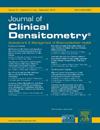Relationships between physical activity and bone mineral content and lean mass in Mexican adolescents
IF 1.6
4区 医学
Q4 ENDOCRINOLOGY & METABOLISM
引用次数: 0
Abstract
Introduction/Background: The acquisition and maintenance of bone and lean mass health are significantly influenced by the mechanical environment of the skeleton, with physical activity emerging as an important factor. Our hypothesis proposes that high-impact physical activity improves bone mineral content and lean mass relationship in healthy adolescents depending on gender, pubertal maturity and skeletal location.
Methodology: We assessed the relation between bone mineral content, and lean mass in whole-body and limbs and leisure-time physical activity in Mexican children and adolescents. We conducted an analysis using data from the “Reference values of body composition in Mexican children and adolescents’ study”, which is a population-based, cross-sectional study. Using standardized protocols, Lunar iDXA instrumentation was used to measure whole-body bone mineral content and lean mass. Using a validated questionnaire, adapted for the Mexican population, the leisure-time physical activity level and the “inactive” condition were determined. ANOVA test was conducted to evaluate curve fitness and produce best-fit equations. Additionally, we used ANCOVA test to evaluate the differences between slopes and intercepts of the curves.
Results: All relationships between bone mineral content and lean mass across various regions were highly significant for all Tanner stages (P < 0.001), irrespective of the type of physical activity. Examining all regions (whole-body bone mineral content vs. whole-body lean mass and lower limbs bone mineral content and lean mass, and upper limbs bone mineral content and lean mass) intercepts were significantly higher in Tanner stage 3-5 compared to Tanner stage 1-2 for both genders (P < 0.001).
Conclusion: These results underscore the nuanced impact of leisure-time physical activity and Tanner stage on the observed relationships, suggesting potential benefits of engaging in specific physical activities during adolescence for bone health during the later stages of puberty.
墨西哥青少年体力活动与骨矿物质含量和瘦体重的关系。
介绍/背景:骨骼的机械环境显著影响骨骼和瘦骨量健康的获得和维持,其中体力活动是一个重要因素。我们的假设提出,高强度的体育活动可以改善健康青少年的骨矿物质含量和瘦质量关系,这取决于性别、青春期成熟度和骨骼位置。方法:我们评估了墨西哥儿童和青少年的骨矿物质含量、全身和四肢瘦质量与闲暇时间体育活动之间的关系。我们使用来自“墨西哥儿童和青少年身体成分参考值研究”的数据进行了分析,这是一项基于人群的横断面研究。采用标准化方案,使用Lunar iDXA仪器测量全身骨矿物质含量和瘦质量。使用一份适用于墨西哥人口的有效问卷,确定了休闲时间的身体活动水平和“不活跃”状态。采用方差分析(ANOVA)检验评价曲线的拟合性,得出最优拟合方程。此外,我们使用ANCOVA检验来评估曲线的斜率和截距之间的差异。结果:骨矿物质含量和瘦体重之间的所有关系在不同地区的所有Tanner阶段都非常显著(P 结论:这些结果强调了休闲时间体育活动和Tanner阶段对观察到的关系的细微影响,表明在青春期后期从事特定的体育活动对骨骼健康有潜在的好处。
本文章由计算机程序翻译,如有差异,请以英文原文为准。
求助全文
约1分钟内获得全文
求助全文
来源期刊

Journal of Clinical Densitometry
医学-内分泌学与代谢
CiteScore
4.90
自引率
8.00%
发文量
92
审稿时长
90 days
期刊介绍:
The Journal is committed to serving ISCD''s mission - the education of heterogenous physician specialties and technologists who are involved in the clinical assessment of skeletal health. The focus of JCD is bone mass measurement, including epidemiology of bone mass, how drugs and diseases alter bone mass, new techniques and quality assurance in bone mass imaging technologies, and bone mass health/economics.
Combining high quality research and review articles with sound, practice-oriented advice, JCD meets the diverse diagnostic and management needs of radiologists, endocrinologists, nephrologists, rheumatologists, gynecologists, family physicians, internists, and technologists whose patients require diagnostic clinical densitometry for therapeutic management.
 求助内容:
求助内容: 应助结果提醒方式:
应助结果提醒方式:


